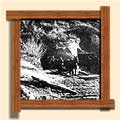 Heritage Community Foundation Presents
Heritage Community Foundation PresentsAlberta Online Encyclopedia
 |
|||
  |
|||
|
Home>> Issues and Challenges>> Health and Safety>> Below Ground |
|||
| Below Ground | |||
Miners who aspired to a Third Class Certificate (or higher rating) also had to have a St. John's Ambulance first aid certificate and a mine rescue certificate. Most miners were satisfied with a simple miners certificate which permitted them. to work at the coal face in the mine. This qualification was usually attained by passing an oral examination from the District Mines Inspector. A Third Class Certificate, granted if the miner passed a day of written, provincial exams, enabled a miner to be in charge of 10 men and to work as a fire boss in smaller mines. A Second Class Certificate permitted a miner to be a foreman, overman or under-manager. He could be a shift boss working under an under-manager who would have at least equivalent qualifications. A miner, with an advanced certificate, could become a Fire Boss who supervised a shift of miners working underground. He was also responsible for testing the air for the presence of methane. For this, he carefully monitored the flame in his safety lamp, a device designed to provide a safe way of testing for gas underground. A First Class Certificate, the most difficult to attain and requiring three days of detailed examinations, meant that the person could be the manager of any coal mine in British Columbia. Curiously, the British Columbia and Alberta ministries of mines did not recognize each other's certificates and for a miner to work in senior positions in another province he had to take that province's exams. For miners working in the Crowsnest Pass where there were mines within a few miles of each other but separated by the provincial boundary, they could not easily work back and forth from one province to the other. See Also:
Miner's Roles and Responsibilities. |
|||
 |
|||
For more on coal mining in Western Canada, visit Peel’s Prairie Provinces.

